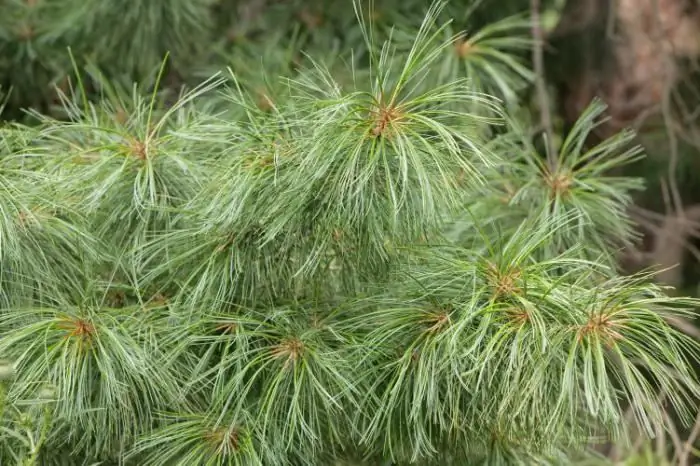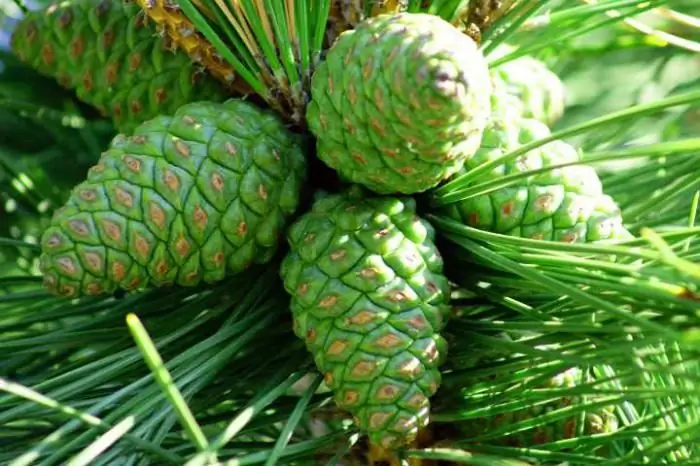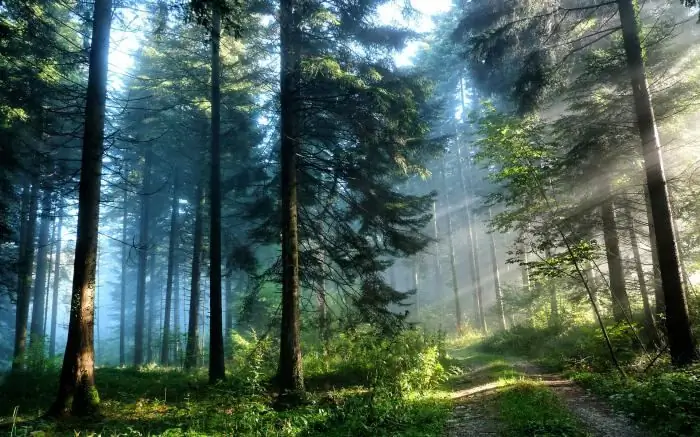- Author Henry Conors [email protected].
- Public 2024-02-12 02:43.
- Last modified 2025-01-23 09:07.
More than a hundred names of trees that make up the genus of pine are distributed throughout the Northern Hemisphere. In addition, some species of pine can be found in the mountains a little further south and even in the tropical zone. These are evergreen monoecious conifers with needle-like leaves.
The division is mainly based on the territorial distribution of the range, although many species of pine plants are artificially bred and, as a rule, are named after the breeder.

General description of the genus pine
The appearance of a pine can be different: most often it is trees, and sometimes creeping shrubs. The shape of the crown changes with age from pyramidal to spherical or umbrella-shaped. This is due to the death of the lower branches and the rapid growth of the branches in breadth.
The shoots on which the needles are collected are normal, shortened or elongated. The needles, collected in bunches, are flat or triangular, narrow and long, do not fall off within 3-6 years. Small scales are located around the base. The fruits are cones within which seeds develop (with and without wings).
In general, various types of pine are not too whimsical, drought-resistant, frost-resistant and do not require fertile soil. Plants prefer dry sandy and rocky soils, although in this matter the Weymouth, Wallich, resinous and cedar pines are exceptions, which readily grow with moderate moisture. Limestone soil is suitable for mountain pine. Now let's take a closer look at some varieties of this culture.
Scotch pine
This is perhaps the most common coniferous tree in Eurasia, which can be called a symbol of the Russian forest. The common pine species is photophilous, it feels normal both in the harsh northern climate and in the steppe heat. It hardly tolerates urban conditions, but it is the main crop for creating forests on sandy soil. In landscape design, Scotch pine is in demand for its variety of decorative forms and rapid growth.
A tree can grow up to 40 meters. The bark is cracked, red-brown, in a young plant it is thin, slightly orange. The needles are bluish in color, double, hard, even or curved, 4-6 centimeters long. The maximum age of a tree under favorable conditions is 400-600 years.
There are many artificially bred low-growing and dwarf varieties of Scots pine. Under natural conditions in the territory of the range, it occurs in a variety of forms and easily crosses with species such as black and mountain pines. ATDepending on the area of growth, about 30 ecological forms are also distinguished - ecotypes.
Siberian cedar pine
Other types of pines are also popular. In Russia, one of the most valuable forest tree species is Siberian cedar pine - a powerful tree with a rich multi-peaked ovoid crown. The needles are short (6-13 cm), rough. It is frost-resistant, grows near the permafrost zone, in the taiga zone. The seeds of the large cones are edible and rich in fatty oils. It reaches a height of 3 meters.
Siberian cedar pine
Distributed in Western Siberia and the Far East. Cedar dwarf pine has a bushy shape, grows densely and has the ability to take root with branches lowered to the ground. It is an ornamental variety due to its beautiful bluish-green needles, bright red male spikelets and showy red-violet buds.
Weymouth Pine
Very beautiful and tall pine.

Varieties and species of North American conifers are of great economic importance. Weymouth pine is characterized by thin, soft and long bluish-green needles. The cones have a curved elongated shape. It perfectly withstands severe frosts, but for all its unpretentiousness it is not suitable for planting greenery in the city.
Weymouth mountain pine
Some well-known species of pine grow in the Crimea, for example, the Veymouth pine. This is a very beautiful North American variety, which differs from the previous shortened blue-green needles and large, somewhat curved buds. Heightof an adult tree - about 30 meters, the crown is narrow, reddish pubescence on young shoots is characteristic. This is a heat-loving tree, although it is difficult to tolerate drought. It grows mainly in those mountainous areas that are protected from sea winds.
Pallas Pine (Crimean pine)
Another species widespread on the Crimean peninsula. Pallas pine is a tall tree, about 20 meters. The bark is reddish-black, speckled with cracks. The crown is dense, changing shape from ovoid to umbrella-shaped. Differs in horizontally spread branches with the ends bent up and large cones. The Crimean pine is photophilous, undemanding to the soil, easily transfers a lack of moisture. Also grows in the Caucasus, Crete, the Balkans, Asia Minor.
Armand Pine
Decorative Chinese species with characteristic long and thin needles, edible oil seeds. Grows exclusively in warm southern regions.

Pine Banks
Distinguished by its multi-stemmed structure, imported from North America. The light green needles are quite short and twisted, the cones are curved. Grows up to 25 meters in height. Frost-resistant, unpretentious species suitable for any soil. Bred only in botanical gardens.
Geldreich Pine
This species is common in the Balkans and southern Italy. It is characterized by spectacular long needles of pale green color. Like many other types of pines, the photos of which are presented in the material, it is very unpretentious, moreover, it easily tolerates urban conditions. Weakness - insufficiently winter-hardy forthe middle lane, so it is ideal for the southern regions.
Mountain Pine
Mountain pine is also very attractive. Pine species are scattered throughout the Northern Hemisphere. This species grows in the mountains of Central and Southern Europe. It is a large branched tree or a prostrate dwarf. Of particular interest for landscape design are a variety of compact decorative trees, from which they create beautiful compositions along the banks of reservoirs, in rocky gardens, etc. The maximum height is 10 meters, and the minimum is 40 centimeters.

Dense-flowered pine
One of the winter-hardy species grown in central Russia is the so-called red Japanese pine. The main condition for its good growth is not too long freezing of the soil. The needles are long and crowded at the end of the branch; during dusting, the tree exudes aroma. Does not accept urban conditions, grows on poor sandy soils.
Small-flowered pine, or white pine
Japanese species of ornamental pines are small-flowered (white) pine, which got its second name for the spectacular white or bluish stripes on the needles, pronounced due to twisting. It is not winter-hardy, only a short dwarf variety grows in central Russia. Since the tree loves warmth and good lighting, the climate of the Black Sea coast is perfect for it.
Pine yellow
Luxury species with a narrow, pyramidal, openwork crown grows naturally in North America. It has long needles and beautiful thickbark. It takes root in the southern regions and central Russia, but freezes in especially cold winters. The height of the tree reaches 10 meters. Prefers places protected from the winds, so it is best to plant in groups. Pine yellow is not susceptible to urban harmful conditions.
Pine European cedar
The European species of cedar pine is similar to the Siberian "relative". The difference lies in the smaller size, denser spreading crown and long thin needles. In addition, the cones and seeds of the tree are not so large. Grows slower but lives longer. Will look perfect in single and group garden plantings.
Korean cedar pine
Quite a rare decorative species growing in the Far East, East Asia, Korea, Japan. In beauty, this coniferous tree can be compared with the Siberian cedar pine, although the crown of the “Korean woman” is less dense, pubescent with bluish-green needles and decorated with decorative cones. The nut seeds are also edible. The culture tolerates frosts in central Russia relatively normally, grows as a stunted tree, although in the wild its height can reach 40-50 meters.
Montezuma Pine
Owner of very long needles, naturally found in western North America and Guatemala.

The tree grows up to 30 meters high and has a sprawling spherical crown. Huge conical cones can reach a length of 25 cm. It prefers a warm and humid climate, so it takes root well in the Crimea. Not susceptible to disease andthe influence of pests.
Pine bristlecone
Many ornamental pine species, including spiny pine, grow well and bear fruit in the conditions of central Russia. This North American species is quite rare and is a small tree or bush with raised branches that form a lush spreading crown. The needles are thick, and the cones have long spines. All varieties are unpretentious and winter-hardy.
Rumelian pine
A variety of Balkan pine has a low pyramidal crown, dense green needles 5-10 centimeters long and cylindrical hanging cones on legs. Young shoots are bare. The bark is brown, flaky. Rumelian pine grows quickly and does not have special requirements for lighting and soils. Used in park decoration.
Twisted pine (broad coniferous)

Grows in North America and due to good winter hardiness is bred in central Russia. The culture extends over large areas along the Pacific coast. The name is given for the twin twisted needles. It can be a shrub or a tall (up to 50 meters) tree, the lower branches of which are lowered, and the upper ones are either sprawling or directed upwards. The culture grows quite slowly, but it is unpretentious to the living conditions not only in nature, but even in the city.
Thunberg Pine
A rare decorative species from Japan, which is also called black pine. The main habitat is alpine forests, about 1000 meters above sea level. This evergreen tree grows up to 40 meters in height. Crownusually irregular in shape, light green in color, with long stiff needles (8-14 cm x 2 mm). The bark is black and the young shoots are orange and glabrous. The cones of the Thunberg pine are almost flat, and the gray seeds are winged. A heat-loving and moisture-loving culture that grows well in Sochi in our country.
Himalayan pine (Wallich or Wallich)
Luxury longleaf pine came from the Himalayas and from the Tibetan mountains. It grows quickly, does not tolerate frosts too well, it is moisture-loving. The ideal place for culture in our country is Crimea, where it bears excellent fruit. The tree in nature reaches a height of 30-50 meters. Beautiful 18 cm gray-green needles hang down. Decorative yellow cones are also long - about 32 centimeters. The species is cultivated for group landscape plantings.
Black Pine
Many decorative species of pines are wild, including black pine, which came to us from the mountainous regions of Central Europe. This breed is very resistant to urban conditions. The name was given for the very dark bark and dense green needles that grow profusely. This creates shady areas, unlike Scots pine. In Russia, it is more suitable for the steppe part of the North Caucasus, although undersized decorative forms can be bred further north.

What are pine cones?
Different types of pine cones differ in their shape, size and color. But all of them are soft, yellow-green at the beginning of life, and as they grow older, they become stiff and change color from dark green to brown.
The largestThe sizes are the cones of American Lambert pines - 50 centimeters long, Coulter - reach 40 centimeters, as well as Cilician fir, growing about 30 centimeters long. The smallest cones, barely reaching 3 centimeters, have Lyell larch and Japanese pseudo-hemlock.
In general, the genus of pine trees is characterized by rapid development and growth. The exceptions are those species that have to survive in difficult climatic conditions: high in the mountains, in swamps, on mean stony soil, in the North. In these cases, mighty trees are reborn into stunted and dwarf varieties. However, they are of great interest for decorating landscape plantings.






